Although the golden age of railroads is long past, clearing rail extensions is just one of the infrastructure pioneering projects that TJs LandClearing – a Fairbanks, Alaska company routinely accomplishes. In addition, they often cut roads to remote Alaskan villages, clear right-of-ways for electric utilities as well as fiber optics, and even cut vegetation from areas that will be runways and hangars when relocating airports.
Remote doesn’t begin to describe it. Calling the conditions cold qualifies for the understatement of the year. And to top it off, Tom Gross and his crews wear headlights because at best, the conditions are dusk-like. Few people in the world are equipped to handle this kind of work – and few would probably want to. But it is all in a day’s work for Tom Gross and his LandClearing crews.
A New Definition of Remote
Every contractor talks about the importance of equipment durability and uptime. But when you routinely work hundreds of miles from the nearest town, downtime can be disastrous – ruining not only your project timeframe, but your reputation as well. Throw in a few months of weather where the high temperatures are sub-zero while working in extremely dark and remote locations, and you get a glimpse of what life is like for TJ crews. Despite these conditions, Gross has found that Fecon mechanical mulchers are a hot commodity by keeping his crews productive throughout the long, dark, and frigid winter – and keeping his well-earned reputation intact.
One aspect of Alaska that often draws visitors and new residents is the vast expanse of natural areas that are so prevalent. It is a beautiful sight – and a welcome one for a man whose company earns a living through vegetation reduction.
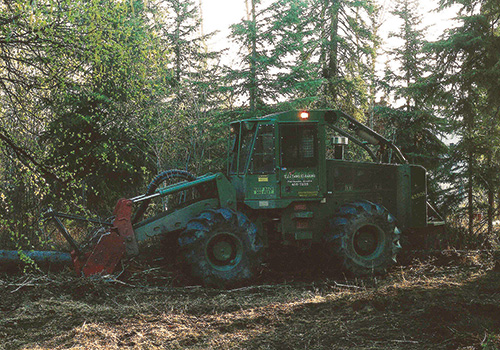
“We do infrastructure preconstruction – all sorts of vegetation reduction and clearing,” explains Gross, whose arsenal of equipment includes 2 Franklin C4550 rubber tired tractors fitted with BH120 mulchers, a Franklin 5000 with a BH120 mulcher, a tracked Takauchi TL150 with a BH74 mulcher head mounted to it, and a SuperTrax 200 fitted with a BH120. The Franklin tractors deliver between 200 and 215 HP to the masticator heads – allowing Gross and his crews to mulch anything in their path, and easily meet the chip size spec from the Alaskan DOT. “The fixed teeth and the counter-cutters really blow apart heavy woody debris,” continues Gross, but he is quick to point out that, “we don’t do any earth moving.”
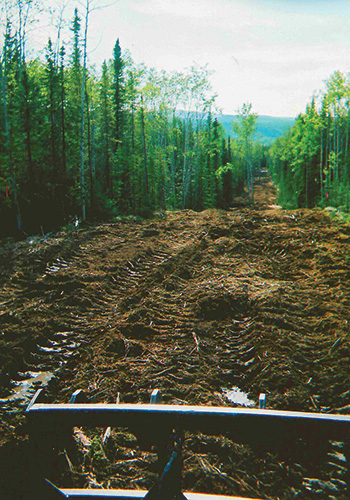
This type of vegetation reduction is required for clearing in advance of infrastructure projects like the railroad track laid from Fort Mackenzie after TJ’s crews cleared the path. Bringing roads or electric utilities to remote villages is another area where Gross’ team excels. Clearing right-of-ways for new power lines and maintaining existing ROWs are two types of projects that they specialize in. Fiber optics is another area where they excel. But getting power to the people who call the 49th state home does not mean that you are necessarily close to any amenities. Gross recalls a few specific projects that epitomize just how desolate and challenging it can be.
“We did a project on the Canadian border, where we were 300 miles from the nearest sizable town and more than 400 miles from Anchorage,” recalled Gross. “The nearest place for any support at all was 110 miles away. So, you might be able to get a (hydraulic) line made, but if a pump quits, you are outta luck.”
At those distances you can burn a couple days just getting parts. And that’s if they are on the shelf. Special pumps, gears, and fittings that are not stock items present problems.
“Alaska in and of itself is notoriously expensive to do business because you are so far away from the real world,” continues Gross. “A lot of logistical planning must take place.”
Part of that planning means knowing what sort of spares you might need, and bringing those with you. But inventorying spares also cuts down on job profits, so it is a balancing act. Another part of the logistics equation is bringing enough fuel – not just for the equipment but for the heaters as well.
“A lot of the ground is soft up here, so you have to work when the ground is frozen. That means you are working in the cold. It is 40-degrees below zero up here today, and that is ambient temp without wind.”
Working in these conditions requires Gross and his crews to take precautions that most of us have never dreamed about.
“We put parachutes over the machines and let the heaters run,” says Gross. “When they are blowing full time you are burning between 9 and 10 gallons an hour of fuel – and you have to keep that sucker going with the machine under there because you are not going to start the machines cold. At 25-degrees below zero the hydraulic oil is as thick as molasses. And those sensitive hydraulic systems will not tolerate that thick syrupy fluid.”
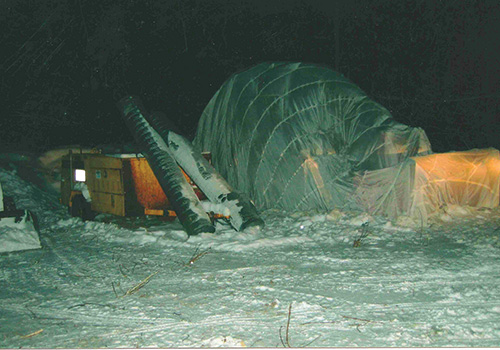
All Obstacles Present Challenges
In addition to severe weather, Gross and his crews also have endangered species, extremely difficult access, and even mating seasons to contend with. A case in point was the Golden Valley Electric Association Northern Intertie project which included 105 miles of power line right of way clearing that was 150 feet wide. This highly visible project included a total of 1,900 acres – some of which was only accessible on foot or by helicopter. Work was stopped by hunting seasons for moose which runs most of September, and for bear, which is encompassed within that timeframe. Additionally, the Migratory Bird Act, originally devised to safeguard raptors like peregrine falcons, eagles, osprey, and other large avian predators, now affords protection for any birds nesting in the spruce, birch, willow or alder trees commonly found in Alaska’s interior.
Cold? BRRRR-ing It On!
While pausing for animal migrations and hunting season are not the norm, more often than not TJs crews are working in the cold. In the deep of winter, Gross and his crews run their heaters all night and perform service in the mornings. Just how much heat does it take to overcome these frigid temperatures?
“After the machine has been under that parachute with that heater blowing a million BTUs – and that’s not an exaggeration – one million BTUs of heat under those parachutes trying to thaw them back out – then you can get the zircs to take grease. When you can get oil to move – then you fire up the machines.”
Given the demands required to keep fluids flowing in these frigid climes may prompt readers to ask whether mechanization is really the answer under such conditions. Gross is quick to point out the production advantages inherent with the mulchers.
“The biggest advantage of mechanical mulching in general and Fecon in specific is that mechanical vegetation reduction is quicker and safer than having men on the ground.”
Gross figures that in typical Alaskan vegetation – not riparian vegetation – but typical spruce, birch, willow and alder (from 3 to 10-inches in diameter), his crews can clear an acre a day. That’s one man, and one machine – a BH120 operating with 205 horsepower— clearing an acre in a 9-hour day.
Contrast that with hand crews and you’d have 8 sets of boots on the ground working a day and a half – or a total of 96 man-hours for clearing and chipping. Mechanization is much safer than 8 guys wielding chain saws on uneven footing in cold climates.
Versatility to Meet Any Job Spec
Gross appreciates that he can handle virtually anything he encounters on projects with his mulcher heads. After the equipment has passed through, it leaves a carpet of mulch in its wake. Gross and his crews leave the organics in place to aid in erosion control.
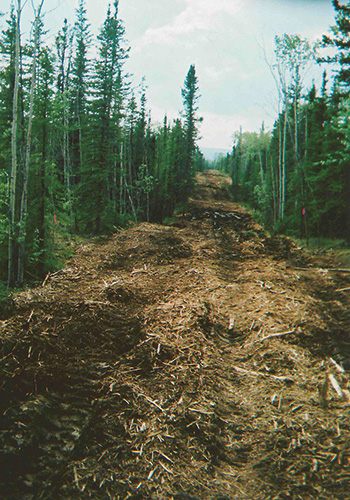
But versatility to shred everything in its pathway is just one aspect of the Fecon story. If the project calls for it, he can even work some of the mulch into the top layer of soil by adjusting the mulchers’ ‘shoes,’ as might be the case in fiber optic clearing projects. The same result, if accomplished by hand, would require additional steps – and time.
For other projects, however, minimal disturbance of the ground is essential because the work is all permit-driven and must be done when the ground is frozen. Here Gross and his teams mulch to ground level but no deeper – again thanks to the adjustable shoes on the mulcher heads.
Gross has observed plenty of other mulchers and has found that while they attempt the same task, they are not all the same. Before buying his first mechanical mulcher 11 years ago, he “researched the heck out of them.” Now that he’s got a fleet of mulchers, he continues to survey what is available to make sound decisions for future projects.
“We look at way they are constructed,” continues Gross, “the gauge of metal, how things are set up, how pumps are run, how easy they are to service, and flat durability. They say that you only get so many hours out of these pumps, or these cutting tools, and we’ve far surpassed the hours on that from where they are saying the wear should be – we’re getting more time out of our stuff.”
Others in the industry do not fare quite so well, however. Gross recalled a competitor who recently purchased a different brand of mulcher, and had “the whole cutting head fall off.”
It takes a special breed of person to live and work in these environments. Forget the Holiday Inn—most often crews end up camping by the equipment and checking heaters throughout the night. Gross has plenty of stories of similar conditions – setting up tents by the equipment – and the photos to prove he’s not just spinning yarns.
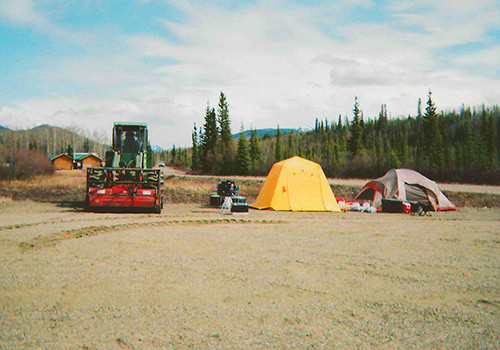
But these self-reliant workers are lost without equipment as durable and hard working as they are.
“Equipment that is accountable,” says Gross, “that’s what it is all about. It is tough up here, so you need tough gear… and Fecon makes tough gear.”
About the Authors
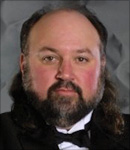 Tom Gross is President of TJ’s Land Clearing, a Fairbanks, AK based land clearing contractor that specializes in clearing projects for infrastructure including roads, railroads, airports, and ROW clearing for utilities. Although originally from North Dakota, Gross settled in Alaska after being stationed there in the military. He started TJ’s in 1988 as a completely hand-clearing operation and has grown it into a largely mechanized one. He is also an accomplished opera singer, performing as a Lyric Tenor. Tom earned a BS in Biological Science with an emphasis in Marine Science from the University of Alaska, Fairbanks in 1994.
Tom Gross is President of TJ’s Land Clearing, a Fairbanks, AK based land clearing contractor that specializes in clearing projects for infrastructure including roads, railroads, airports, and ROW clearing for utilities. Although originally from North Dakota, Gross settled in Alaska after being stationed there in the military. He started TJ’s in 1988 as a completely hand-clearing operation and has grown it into a largely mechanized one. He is also an accomplished opera singer, performing as a Lyric Tenor. Tom earned a BS in Biological Science with an emphasis in Marine Science from the University of Alaska, Fairbanks in 1994.
 Courtney Shafer is the Manager of Marketing Services at Fecon, Inc, a Lebanon, OH based manufacturer of forestry tracked carriers and attachments for use in the land clearing, vegetation management & Right-Of-Way industries. Courtney earned a BA in Public Relations with a Minor in Radio/Television from Northern Kentucky University. She has been with the company for five years.
Courtney Shafer is the Manager of Marketing Services at Fecon, Inc, a Lebanon, OH based manufacturer of forestry tracked carriers and attachments for use in the land clearing, vegetation management & Right-Of-Way industries. Courtney earned a BA in Public Relations with a Minor in Radio/Television from Northern Kentucky University. She has been with the company for five years.







